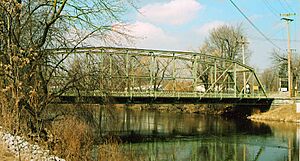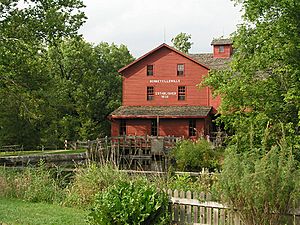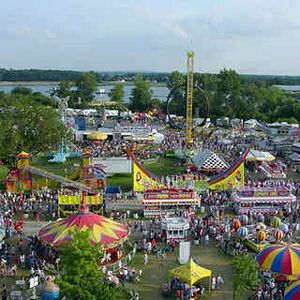Elkhart County, Indiana facts for kids
Quick facts for kids
Elkhart County
|
|
|---|---|
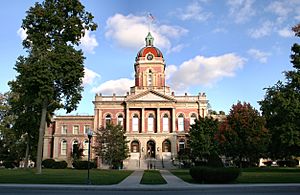
Elkhart County courthouse in Goshen, Indiana
|
|

Location within the U.S. state of Indiana
|
|
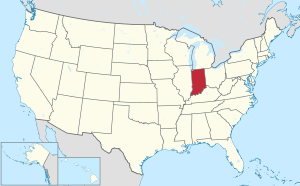 Indiana's location within the U.S. |
|
| Country | |
| State | |
| Founded | April 1, 1830 |
| Seat | Goshen |
| Largest city | Elkhart |
| Area | |
| • Total | 467.97 sq mi (1,212.0 km2) |
| • Land | 463.17 sq mi (1,199.6 km2) |
| • Water | 4.80 sq mi (12.4 km2) 1.03% |
| Population
(2020)
|
|
| • Total | 207,047 |
| • Estimate
(2023)
|
206,409 |
| • Density | 442.436/sq mi (170.8257/km2) |
| Time zone | UTC−5 (Eastern) |
| • Summer (DST) | UTC−4 (EDT) |
| Congressional district | 2nd |
| Indiana county number 20 | |
Elkhart County is a county located in the state of Indiana. In 2020, about 207,047 people lived here. The main city where the county government is located is Goshen.
Elkhart County is part of a larger area called the Elkhart-Goshen Metropolitan Statistical Area. This area is also part of the South Bend-Elkhart-Mishawaka Combined Statistical Area. It's also known as Michiana, a region in Northern Indiana. The county is about 20 kilometers east of South Bend, Indiana. It's also about 110 kilometers east of Chicago, Illinois, and 150 kilometers north of Indianapolis, Indiana.
Many people call this area the "RV Capital of the World." This is because many recreational vehicles (RVs) are made here. Elkhart County is also home to a large number of Amish and Old Order Mennonite people.
Contents
History
In the early 1800s, the Potawatomi tribe lived in the area that is now Elkhart County. In 1829, settlers, also called pioneers, began to move into the Elkhart Prairie area. On April 1, 1830, Elkhart County was officially created. The first main city for the county government was Dunlap. Later, the county borders were changed, and the main city was moved to Goshen. Goshen is closer to the center of the county.
Many of the first settlers in Elkhart County came from New England. These were people whose families had lived in New England since the 1600s. The completion of the Erie Canal helped more people from New England move to this area. After the Black Hawk War, even more people came, mostly from the six New England states. Some of these settlers had lived in upstate New York before moving to Elkhart County.
These early settlers were often part of the Congregational Church. Many of them were against slavery before the Civil War. Because of this, many people from Elkhart County fought for the Union Army during the Civil War. Later, in the late 1800s, people of Irish and German backgrounds also moved to Elkhart County. Most of them came from other parts of the Midwest, like Ohio.
Name of the County
There are a few ideas about how Elkhart County got its name. One idea is that it was named after a tribe called Elkhart, but there is no proof of this. Another idea, found on the city's website, says that Island Park in Elkhart looks like an elk's heart. However, it's not clear how people would have known this from above back then.
The most likely idea is that the county was named after a Shawnee chief named Elkhart. He was a cousin of the famous Chief Tecumseh. Chief Elkhart was also the father of Princess Mishawaka, after whom the nearby city of Mishawaka is named.
Geography
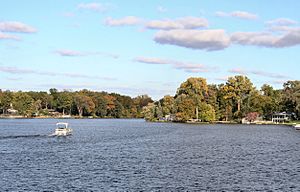
Elkhart County covers about 468 square miles. Most of this area, about 463 square miles, is land. The rest, about 4.8 square miles, is water. The county has mostly flat farmland. There are some gentle hills in the northeast part. These hills were formed by glaciers long ago. They are part of a special area called the St. Lawrence Seaway Continental Divide.
The St. Joseph River is the main river in Elkhart County. It flows from Michigan into the county near Bristol. The Elkhart River enters the county near Millersburg. It then flows through Goshen and Dunlap before joining the St. Joseph River in Elkhart. The Little Elkhart River also flows into the county. It creates beautiful views in Bonneyville Mills County Park. Many small creeks and lakes are also found throughout the county. Simonton Lake is one of these lakes.
There are also fifteen smaller communities in the county that are not officially cities or towns. These include Benton, Bonneyville Mills, Dunlap, Foraker, Garden Village, Jimtown, Locke, Midway, New Paris, Nibbyville, Simonton Lake, Southwest, Vistula, and Waterford Mills.
Townships
|
|
|
|
Neighboring Counties
- St. Joseph County, Michigan (to the northeast)
- Lagrange County (to the east)
- Noble County (to the southeast)
- Kosciusko County (to the south)
- Marshall County (to the southwest)
- St. Joseph County (to the west)
- Cass County, Michigan (to the northwest)
Communities
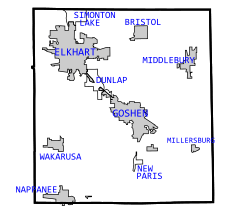
Cities
Towns
Census-Designated Places
- Dunlap
- Simonton Lake
Other Small Communities
Economy
Elkhart County is famous as "The RV Capital of the World." This means a big part of its economy comes from making recreational vehicles (RVs). Farming is also very important to the local economy.
Tourism also helps the county's economy. Places like Das Dutchman Essenhaus in Middlebury and Amish Acres in Nappanee attract many visitors. Annual events like the Elkhart Jazz Festival and the Amish Acres Arts & Crafts Festival also bring in thousands of tourists. The Elkhart County 4-H Fair is the second largest county fair in the United States.
Climate and Weather
| Weather chart for Goshen, Indiana | |||||||||||||||||||||||||||||||||||||||||||||||
|---|---|---|---|---|---|---|---|---|---|---|---|---|---|---|---|---|---|---|---|---|---|---|---|---|---|---|---|---|---|---|---|---|---|---|---|---|---|---|---|---|---|---|---|---|---|---|---|
| J | F | M | A | M | J | J | A | S | O | N | D | ||||||||||||||||||||||||||||||||||||
|
1.8
31
17
|
1.8
36
20
|
2.7
48
29
|
3.4
61
39
|
3.4
73
49
|
4.1
81
59
|
3.5
85
63
|
4
82
61
|
3.6
76
54
|
2.9
64
43
|
2.8
50
34
|
2.7
36
23
|
||||||||||||||||||||||||||||||||||||
| temperatures in °F precipitation totals in inches source: The Weather Channel |
|||||||||||||||||||||||||||||||||||||||||||||||
|
Metric conversion
|
|||||||||||||||||||||||||||||||||||||||||||||||
In Goshen, average temperatures usually range from about 17°F (minus 8°C) in January to 85°F (29°C) in July. The coldest temperature ever recorded was minus 24°F (minus 31°C) in January 1984. The hottest was 102°F (39°C) in June 1988.
The amount of rain and snow each month varies. February usually gets about 1.77 inches (4.5 cm) of precipitation. June typically gets the most, with about 4.05 inches (10.3 cm).
Population Information
| Historical population | |||
|---|---|---|---|
| Census | Pop. | %± | |
| 1830 | 935 | — | |
| 1840 | 6,660 | 612.3% | |
| 1850 | 12,690 | 90.5% | |
| 1860 | 20,986 | 65.4% | |
| 1870 | 26,026 | 24.0% | |
| 1880 | 33,454 | 28.5% | |
| 1890 | 39,201 | 17.2% | |
| 1900 | 45,052 | 14.9% | |
| 1910 | 49,008 | 8.8% | |
| 1920 | 56,384 | 15.1% | |
| 1930 | 68,875 | 22.2% | |
| 1940 | 72,634 | 5.5% | |
| 1950 | 84,512 | 16.4% | |
| 1960 | 106,790 | 26.4% | |
| 1970 | 126,529 | 18.5% | |
| 1980 | 137,330 | 8.5% | |
| 1990 | 156,198 | 13.7% | |
| 2000 | 182,791 | 17.0% | |
| 2010 | 197,559 | 8.1% | |
| 2020 | 207,047 | 4.8% | |
| 2023 (est.) | 206,409 | 4.5% | |
| 1830 Census. Elkhart County. 1840 Census. Elkhart County. U.S. Decennial Censuses: 1790-1960 1900-1990, 1990-2000, 2010-2019, 2020 |
|||
In 2010, there were 197,559 people living in Elkhart County. There were about 70,244 households. The population density was about 426 people per square mile.
Most people in the county, about 82.9%, were white. About 5.7% were Black or African American. People of Hispanic or Latino origin made up 14.1% of the population. The average household had 2.76 people. The average family had 3.23 people. The median age was 34.9 years old.
The median income for a household was $47,697. For families, it was $53,742. About 13.7% of the population lived below the poverty line. This included 21.5% of those under 18 years old.
2020 Census Details
| Race | Num. | Perc. |
|---|---|---|
| White (Not Hispanic) | 145,039 | 70% |
| Black or African American (Not Hispanic) | 11,051 | 5.3% |
| Native American (Not Hispanic) | 373 | 0.18% |
| Asian (Not Hispanic) | 2,236 | 1% |
| Pacific Islander (Not Hispanic) | 54 | 0.02% |
| Other/Mixed (Not Hispanic) | 8,700 | 4.2% |
| Hispanic or Latino | 39,594 | 19.1% |
Amish and Mennonite Communities
In 2020, the Amish and Mennonite population in Elkhart County was 11,006. This made up about 5.3% of the total population.
Transportation
Roads
The Indiana Toll Road (Interstates 80/90) goes through the northern part of the county. Elkhart has two exits on the Toll Road. Bristol and Middlebury each have one exit. U.S. Route 20 runs along the southern edge of Elkhart. It is a freeway called the St. Joseph Valley Parkway for a while.
County Road 17 is known as the "Michiana Parkway." It connects Goshen, U.S. 20, and the Toll Road. It also connects to US 12 in Michigan. Other important roads include U.S. Highways 6, 33, and 131. Several Indiana State Highways also run through the county.
Other Ways to Travel
A bus system called the Interurban Trolley serves several cities in Elkhart County. It connects Elkhart and Goshen. It also connects to Osceola, Dunlap, and Mishawaka. The buses look like trolley cars.
The county's only Amtrak train station and Greyhound bus station are in Elkhart. Elkhart, Nappanee, and Goshen all have local airports. Amtrak trains stop in Elkhart four times a day.
Education
Elkhart County has seven public school districts. There are also seven private schools and one college. Several other colleges have smaller campuses in the city of Elkhart.
Public Schools
The Elkhart Community Schools is the largest school district. It serves the busy northwest side of the county. This system has fourteen elementary schools and three middle schools. It also has one large high school, Elkhart High School, which was formed by merging two older high schools in 2020.
The Middlebury Community Schools serve the northeast part of the county. This system includes four elementary schools, one intermediate school, one middle school, and one high school, all named Northridge.
The Fairfield Community Schools serve the southeast corner of the county. This system has three elementary schools and a junior-senior high school named Fairfield.
The Wa-Nee Community Schools serve the southwest part of the county. This system has three elementary schools, a middle school, and a high school, both named NorthWood.
The Baugo Community Schools serve the west-central part of the county. This system includes an elementary, intermediate, junior high, and high school, all named Jimtown.
The Concord Community Schools serve parts of Elkhart and Goshen. This system has four elementary schools, an intermediate school, a junior high school, and a high school, all named Concord.
Finally, the Goshen Community Schools serve the central part of Elkhart County. This system has seven elementary schools, a middle school, and a high school, all named Goshen.
Private Schools
There are nine private schools in the county. Kessington Christian School is in Bristol. Elkhart Christian Academy, Trinity Lutheran School, St. Vincent de Paul Catholic School, and St. Thomas the Apostle School are in Elkhart. Bethany Christian, Bashor Alternative School, St. John the Evangelist Catholic School, and Clinton Christian School are in Goshen.
Colleges and Universities
Elkhart County has six places for higher education. Two are located only in the county: Goshen College, a small Mennonite college in Goshen, and the Anabaptist Mennonite Biblical Seminary in Elkhart.
The city of Elkhart also has four smaller campuses of other colleges. These include Bethel College, Indiana Institute of Technology, Indiana University South Bend's "Elkhart Center," and Ivy Tech Community College.
Recreation
County Parks and Natural Areas
Bonneyville Mill Park is a large park with rolling hills, wetlands, and forests. It is located on the Little Elkhart River near Bristol. The park has hiking trails, fishing spots, and picnic areas. You can also take tours of Bonneyville Mill, which still makes flour.
Ox Bow Park is a park that looks over the Elkhart River between Elkhart and Goshen. It has hiking trails, picnic shelters, and a disc golf course.
River Preserve Park is a very large park located along the Elkhart River. It offers trails and picnic areas. It also teaches about the history of Indiana's waterways.
Treasure Island Park offers fishing and canoe access to the St. Joseph River. There are also future park sites at Turkey Creek and Wolf Lake. The cities and towns in Elkhart County also have many parks and green spaces.
Museums to Explore
- Bonneyville Mill, inside Bonneyville Mill Park, shows how a grain mill works.
- The Elkhart County Historical Museum is in Bristol.
- The Jimtown Historic Museum shows what life was like in the 1800s.
- The Midwest Museum of American Art in Elkhart has over 2500 pieces of art.
- The National New York Central Railroad Museum in Elkhart tells the story of old railroads like the New York Central and Amtrak.
- The RV/MH Hall of Fame & Museum is in Elkhart. It celebrates the history of RVs and mobile homes.
- Ruthmere is a beautiful old mansion from 1910. It has art collections, old cars, and gardens.
- "Time Was" is a small museum that shows what life was like in Elkhart in the late 1800s and early 1900s.
Sports Teams
Elkhart's North Side Gymnasium was once home to the Elkhart Express basketball team. The team won two seasons but stopped playing in 2009.
Fun Annual Events
- Bristol has an annual Homecoming Festival in early July. Bonneyville Mill Park hosts a harvest celebration every September.
- Elkhart hosts the Elkhart Jazz Festival and the Rhapsody in Green Summer celebration, both in June.
- Goshen has "First Fridays" events on the first weekend of every month. Many people visit downtown Goshen for these festivals.
- Middlebury holds a Summer Festival every August.
- Nappanee and Amish Acres host the Amish Acres Arts & Crafts Festival at the end of July.
- Wakarusa hosts an annual Maple Syrup Festival every April.
- The Lerner Theater in Elkhart, the Goshen Linway Plaza Theater, and the Amish Acres Round Barn Theater in Nappanee offer live theater shows throughout the year.
All these events bring many people to the county each year. The biggest event is the Elkhart County 4-H Fair. This nine-day event is one of the largest county fairs in the United States.
Media
The Elkhart Truth and The Goshen News are the two daily newspapers in the county. Bristol, Middlebury, and Nappanee also have weekly newspapers.
Elkhart County is part of the South Bend-Elkhart television market. One TV station, WSJV-TV (Fox), is in Elkhart. Several radio stations are also located here, including WTRC and WVPE (NPR). Radio Stations WKAM and Goshen College's WGCS are in Goshen.
Important Moments in the News
- In 1965, a series of strong storms, including tornadoes, affected the county. This event caused significant damage and sadness.
- In 2001, a factory in Goshen received national news attention due to an incident.
- Much of Devil's Playground, a documentary about Amish young adults, was filmed in Elkhart and Lagrange Counties.
- In 2009, U.S. President Barack Obama visited Concord High School in Elkhart. He held a meeting to talk about the economy and his plans to help. He chose Elkhart because it was facing economic challenges at the time.
Notable People
- Edward Bonney (1807–1863), a detective and city planner for the old town of Bonneyville.
- Frederick A. Herring (1812–1908), a textile maker and doctor who lived in Goshen.
See also
 In Spanish: Condado de Elkhart para niños
In Spanish: Condado de Elkhart para niños


